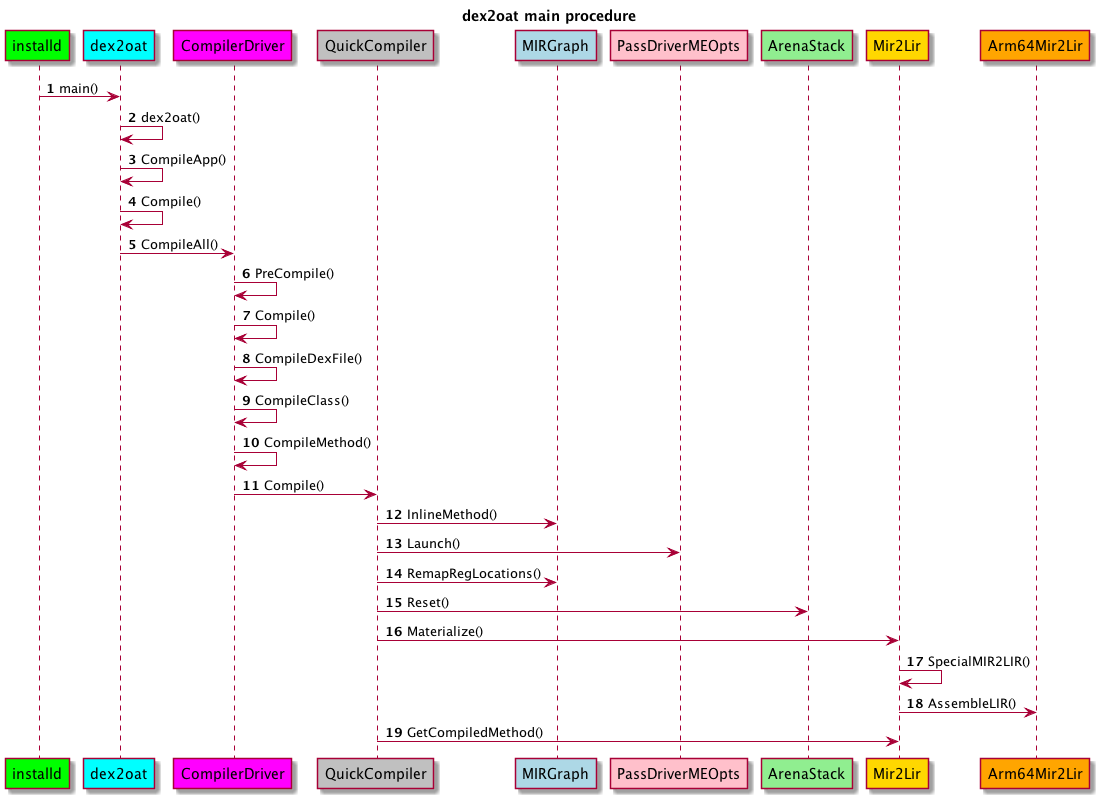ART世界探险(16) - 快速编译器下的方法编译
我们对三大组件有了了解之后,下面终于可以开始正餐,开始分析两种Compiler下的Compile函数。
我们先看一张图,对于整个流程有个整体的印象,然后我们再去看代码:
QuickCompiler的Compile
CompiledMethod* QuickCompiler::Compile(const DexFile::CodeItem* code_item,
uint32_t access_flags,
InvokeType invoke_type,
uint16_t class_def_idx,
uint32_t method_idx,
jobject class_loader,
const DexFile& dex_file) const {
...
CompilerDriver* driver = GetCompilerDriver();上来就是老朋友,先获取CompilerDriver对象。前面我们介绍过,它是调用编译器的驱动接口,大杂烩类。
然后下面判断是不是病态情况,值不值得编译。是不是经过校验。是不是打开了编译开关。
...
if (Compiler::IsPathologicalCase(*code_item, method_idx, dex_file)) {
return nullptr;
}
if (driver->GetVerifiedMethod(&dex_file, method_idx)->HasRuntimeThrow()) {
return nullptr;
}
DCHECK(driver->GetCompilerOptions().IsCompilationEnabled());下面是Runtime和ClassLinker出场,三大组件齐了。
然后是大管家CompliationUnit开始工作。
Runtime* const runtime = Runtime::Current();
ClassLinker* const class_linker = runtime->GetClassLinker();
InstructionSet instruction_set = driver->GetInstructionSet();
if (instruction_set == kArm) {
instruction_set = kThumb2;
}
CompilationUnit cu(runtime->GetArenaPool(), instruction_set, driver, class_linker);
cu.dex_file = &dex_file;
cu.class_def_idx = class_def_idx;
cu.method_idx = method_idx;
cu.access_flags = access_flags;
cu.invoke_type = invoke_type;
cu.shorty = dex_file.GetMethodShorty(dex_file.GetMethodId(method_idx));
CHECK((cu.instruction_set == kThumb2) ||
(cu.instruction_set == kArm64) ||
(cu.instruction_set == kX86) ||
(cu.instruction_set == kX86_64) ||
(cu.instruction_set == kMips) ||
(cu.instruction_set == kMips64));
...
InitCompilationUnit(cu);上面都是在做CompilationUnit的初始化工作,例如这个InitCompilationUnit:
void QuickCompiler::InitCompilationUnit(CompilationUnit& cu) const {
// Disable optimizations according to instruction set.
cu.disable_opt |= kDisabledOptimizationsPerISA[cu.instruction_set];
if (Runtime::Current()->UseJit()) {
// Disable these optimizations for JIT until quickened byte codes are done being implemented.
// TODO: Find a cleaner way to do this.
cu.disable_opt |= 1u << kLocalValueNumbering;
}
}然后开始构建MIRGraph.
cu.mir_graph.reset(new MIRGraph(&cu, &cu.arena));
/*
* After creation of the MIR graph, also create the code generator.
* The reason we do this is that optimizations on the MIR graph may need to get information
* that is only available if a CG exists.
*/
cu.cg.reset(GetCodeGenerator(&cu, nullptr));
/* Build the raw MIR graph */
cu.mir_graph->InlineMethod(code_item, access_flags, invoke_type, class_def_idx, method_idx,
class_loader, dex_file);
...下面创建Pass驱动,然后调用它来做优化。
/* Create the pass driver and launch it */
PassDriverMEOpts pass_driver(GetPreOptPassManager(), GetPostOptPassManager(), &cu);
pass_driver.Launch();
...寄存器重新映射
/* Reassociate sreg names with original Dalvik vreg names. */
cu.mir_graph->RemapRegLocations();清理内存,以便下次复用
/* Free Arenas from the cu.arena_stack for reuse by the cu.arena in the codegen. */
...
cu.arena_stack.Reset();
CompiledMethod* result = nullptr;
...生成机器指令
cu.cg->Materialize();
...消除重复数据,并重复结果
result = cu.cg->GetCompiledMethod();
...
return result;
}我们为下一章节做个小小的预告,下面我们将深入到MIRGraph,CodeGenerator,优化的Pass还有Mir2Lir的激动人心的过程中。
先上一个预告图,顺便复习一下之前所学的流程:



























 3508
3508

 被折叠的 条评论
为什么被折叠?
被折叠的 条评论
为什么被折叠?










